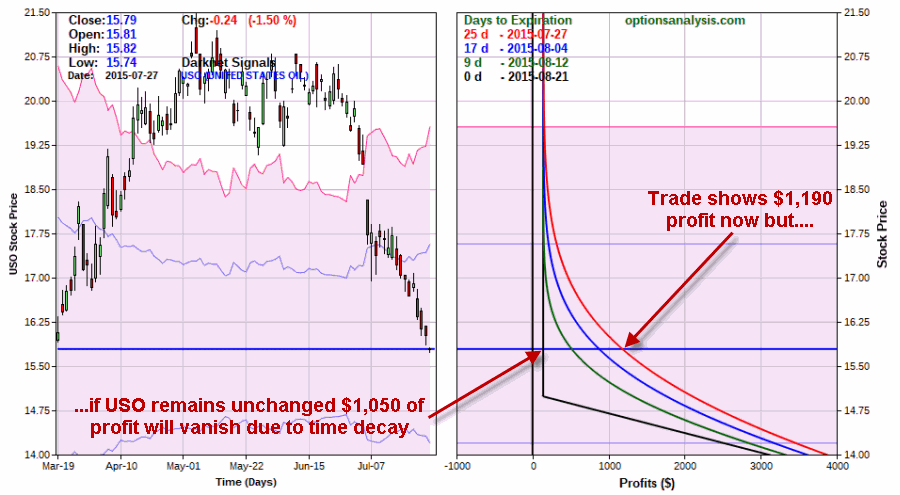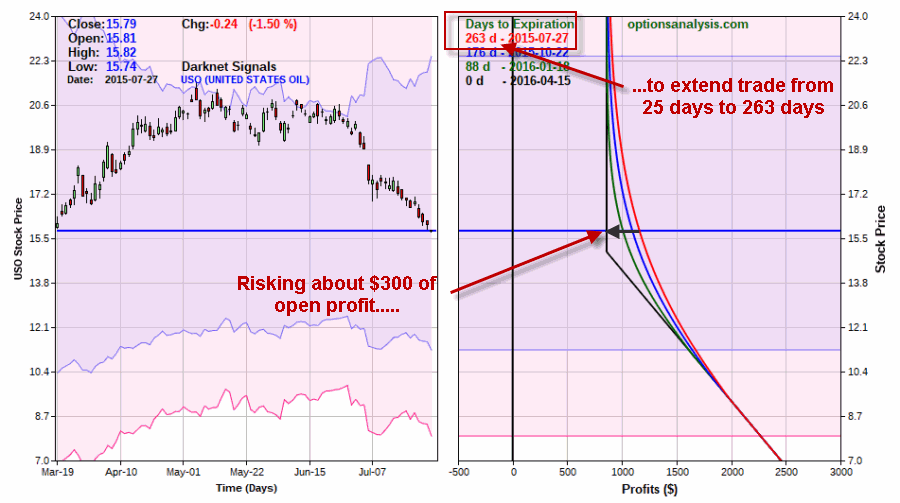A while back I wrote about the potential for crude oil to decline in price – based on nothing but daily and weekly Elliott Wave counts. As this is an approach that may or may not inspire a lot of confidence (depending primarily on the level to which one is or is not an “Elliotthead”), I highlighted an example “limited risk” way to play (i.e., buying put options). Please not that I did not say “low risk”, only limited risk.
Yes, there is a difference. Just to clarify, I refer to buying call or put options as “limited risk” and not “low risk” for the following reason: It is common to hear purveyors of option trading tout the fact that when buying options “you can only lose what you put up.” Which sounds at first like a positive (and is as far as it offers the aforementioned “limited risk”)? However, a corollary – and far less positive sounding – way to phrase it is to say “you can only lose 100% of your investment.”
Wait, what?
Precisely. If you buy a call or put option and it expires worthless you lose 100% of what you put up. Somehow a loss of 100% and the phrase “low risk” just doesn’t quite compute in my poor addled mind. But I digress.
The Original Trade
As detailed in the original article the original trade involved buying 70 USO August 15 puts on 5/13 at $0.14 for a total cost and total maximum risk of $980. Well, things worked out OK.
This trade was adjusted on 7/7 by selling 40 of the 70 puts. This left a long position of 30 puts and locked in a minimum profit of $140. Well crude oil continues to tank which is all well and good for this trade. However, as August expiration draws closer time decay can an extract a heavy toll on this position.
As you can see in Figure 1 and 2 (which displays the expected profit or loss for this trade based on USO price, with each line represented the expected P&L as of a specific day). Much of the current open profit may just wither away unless USO falls well below $15 a share. There are only 25 days left until August expiration and Theta (the Greek value denoting how much the trade will lose in one day based solely on time decay) is -$35. Figure 1 – Original Trade Adjustment (Courtesy www.OptionsAnalysis.com)
Figure 1 – Original Trade Adjustment (Courtesy www.OptionsAnalysis.com)
 Figure 2 – Time decay is a danger between now and August expiration (Courtesy www.OptionsAnalysis.com)
Figure 2 – Time decay is a danger between now and August expiration (Courtesy www.OptionsAnalysis.com)
So it seems like time to “do something.” As always, one could just sell the 30 remaining contracts and take a pretty decent profit. However, as you can see in Figure 3, the Elliott Wave count is still pointing to potentially lower prices for USO. So it could make sense to extend this trade.
 Figure 3 – Elliott Wave still projecting lower for USO (Courtesy: ProfitSource by HUBB)
Figure 3 – Elliott Wave still projecting lower for USO (Courtesy: ProfitSource by HUBB)
As you can see in Figure 1 the trade presently has an open profit of +$1,190. So the goals (at least in this example) are:
*toextend the time left until expiration to potentially garner additional profits, while..
*Not allowing the sizable profit on the original trade to vanish.
So here is one possibility:
*Sell 30 August USO 15 puts at $0.35
*Buy 2 Apr 2016 USO 15 puts at $1.65
The results of this adjustment appear in Figures 4 and 5. The “Days until Expiration” increases from 25 days to 263 days and Theta declines from a whopping -$35 a day to just -$0.73 a day. Figure 4 – Adjusted Trade (Courtesy www.OptionsAnalysis.com)
Figure 4 – Adjusted Trade (Courtesy www.OptionsAnalysis.com) Figure 5 – Risk Curves for Adjusted trade (Courtesy www.OptionsAnalysis.com)
Figure 5 – Risk Curves for Adjusted trade (Courtesy www.OptionsAnalysis.com)
As you can see in both Figures, we are risking roughly $300 of our open profit (i.e., we are playing with the “house money”) with the hope of making more money if USO does in fact fall to $12 or lower as projected by the Elliott Wave count.
Jay Kaeppel

